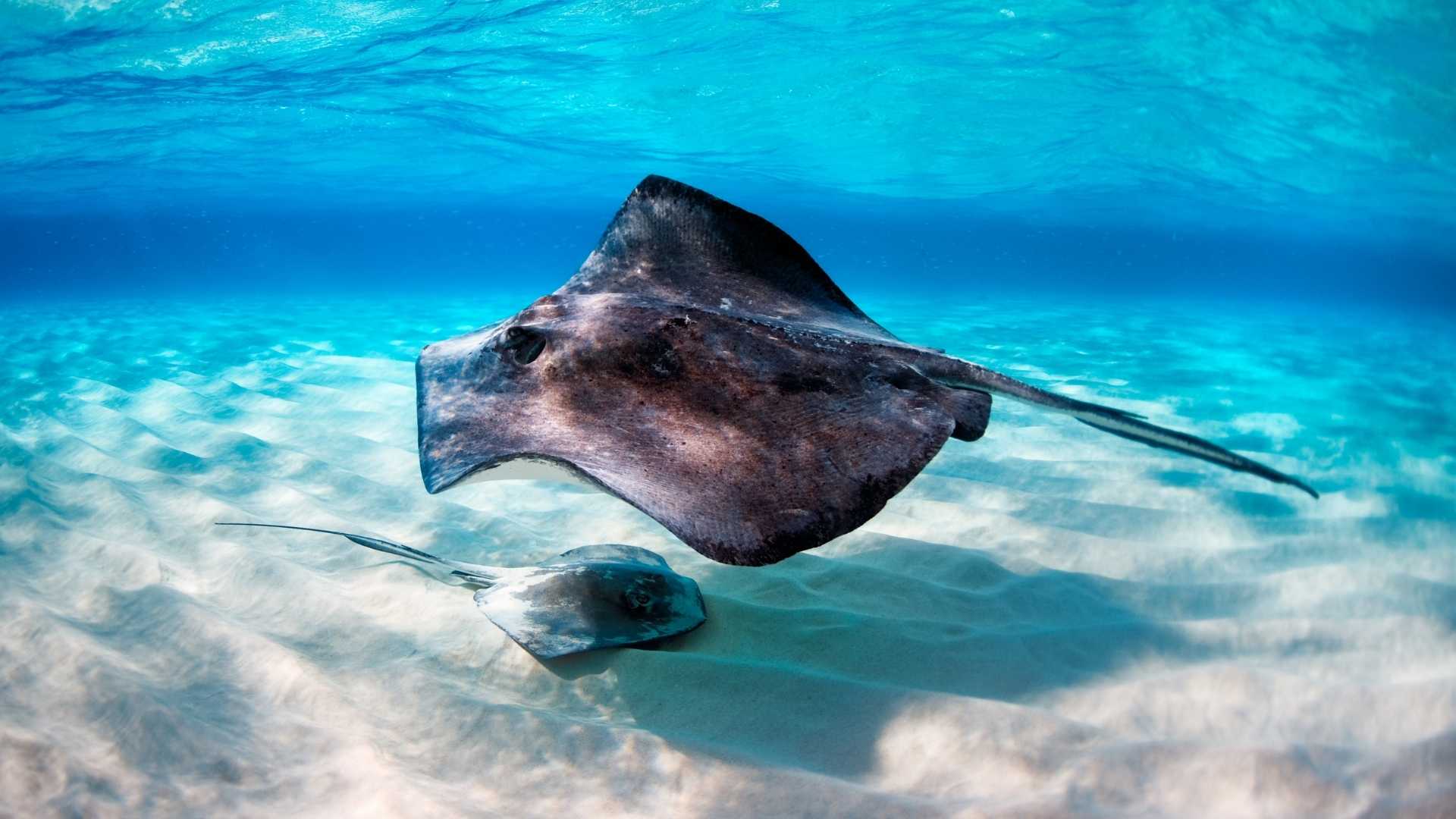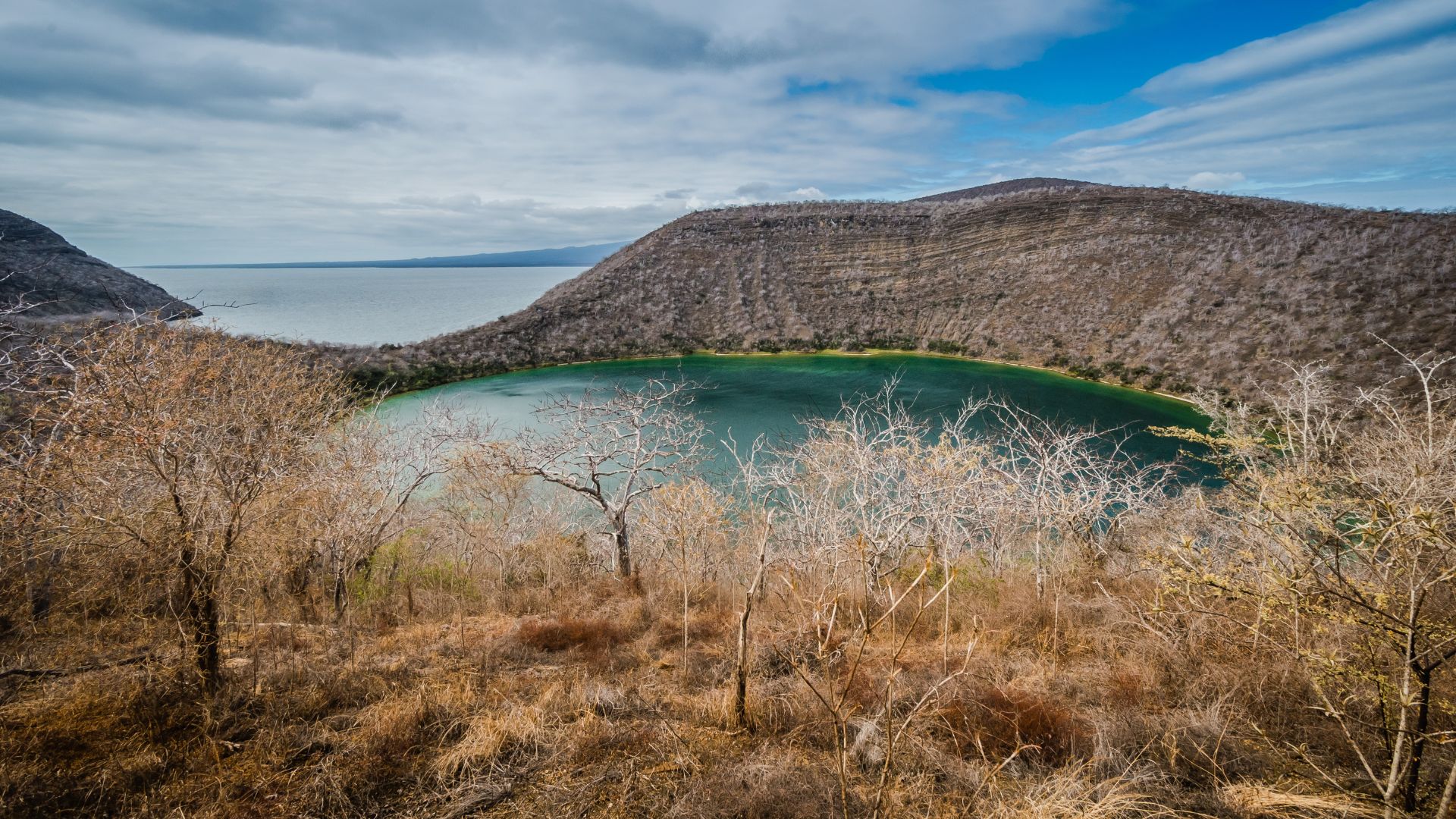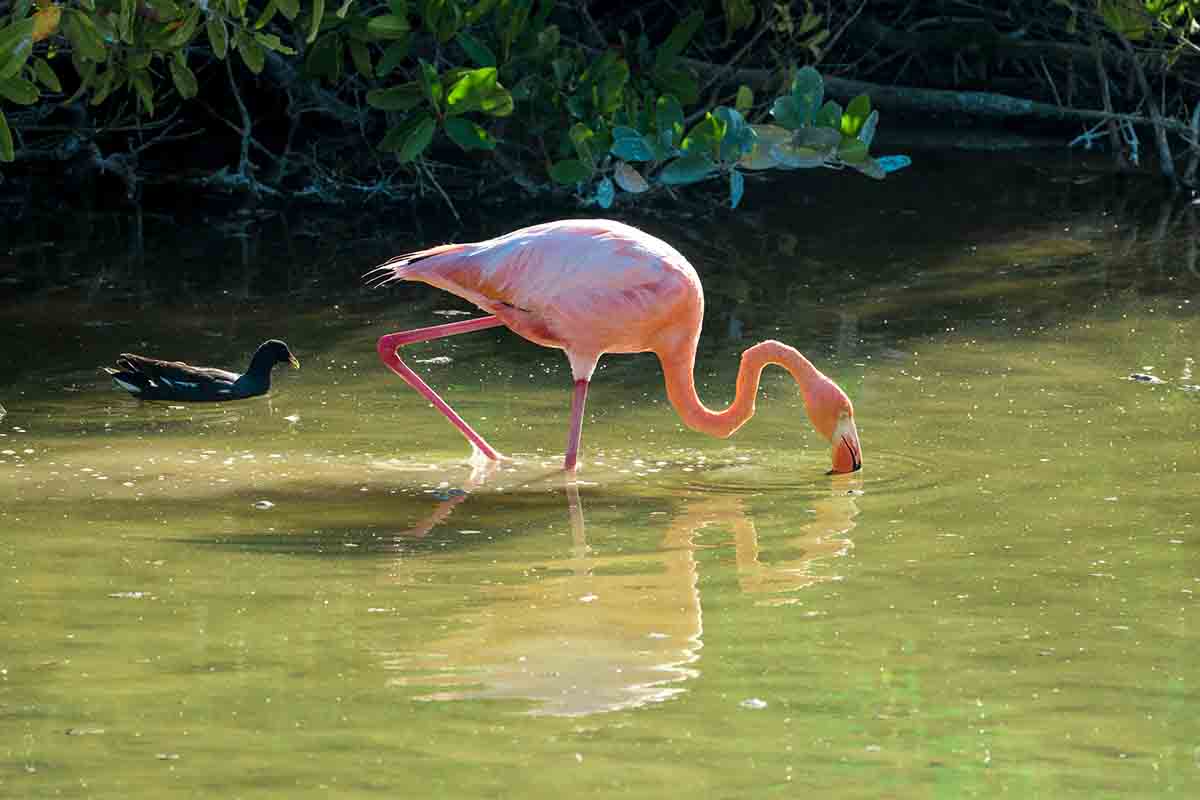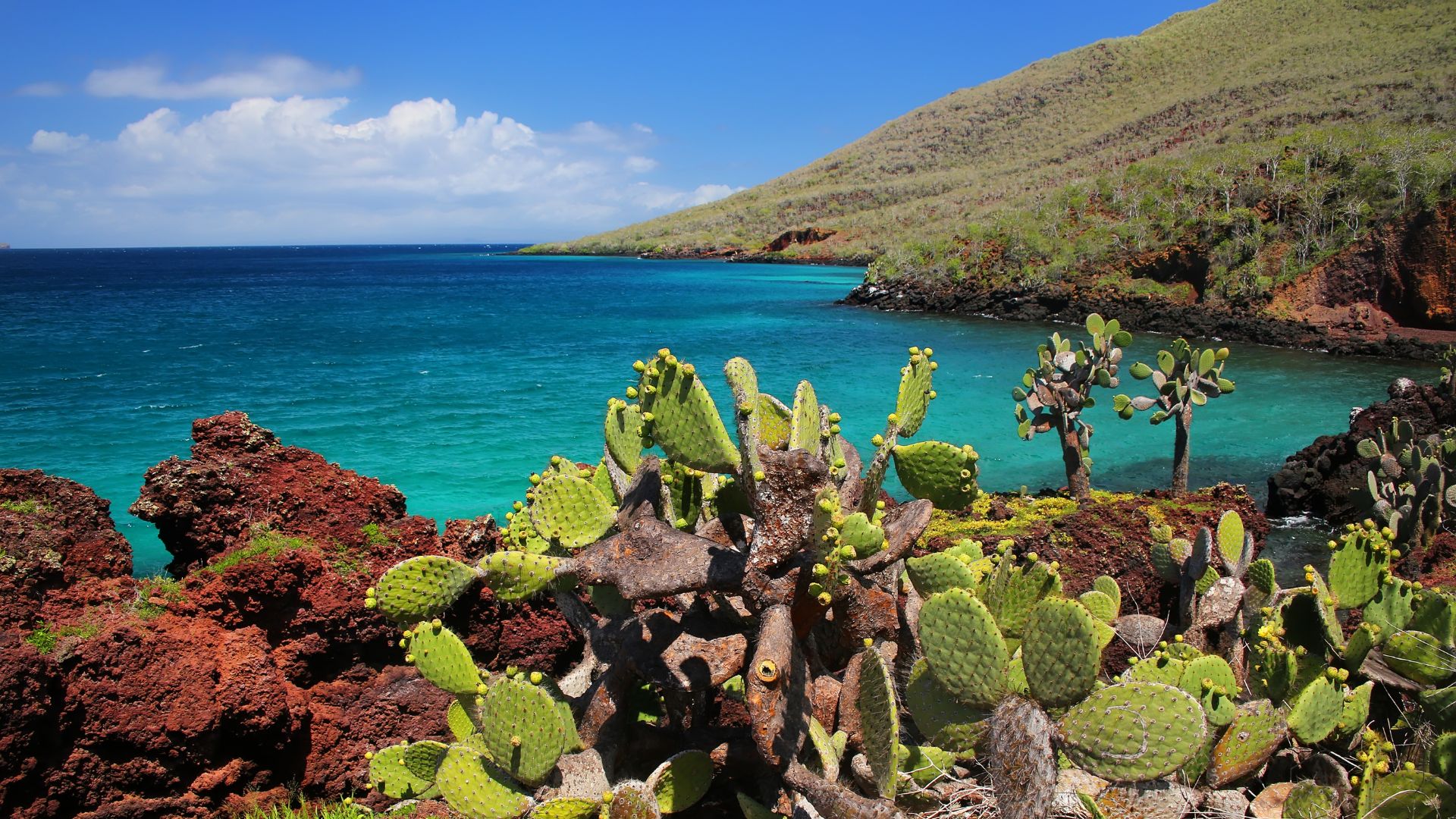This 8-day cruise explores the volcanic landscapes and remote ecosystems of the western Galapagos Islands, including Isabela and Fernandina. It offers diverse experiences such as snorkeling with marine iguanas, hiking through lava fields, and spotting rare species like the flightless cormorant and Galapagos penguins. This tour allows you to experience the youngest and most volcanically active islands of the archipelago, offering both adventure and close encounters with wildlife.
- Sea turtles, black-tip, white-tip, and Galapagos sharks, spotted rays, egrets, and herons contribute to the diverse wildlife.
- Encounter the endemic Galapagos penguins and iconic flightless cormorants
- Visitors can observe land iguanas, red and blue lobsters, and various vegetation, including Darwin’s cotton flowers.
- Airport assistance (Quito or Guayaquil, if flights are booked through LT)
- Transfers in Galapagos
- Accommodation on board in double cabin
- All meals during the cruise
- Naturalist Bilingual Guide level III
- All visits and excursions according to the itinerary
- Snorkel Gear(mask, tube and fins)
- Kayaks
- Unlimited purified water, coffee and tea
- Round trip flight to/from Galapagos
- Galapagos National Park Entrance fee USD 200 p/p
Galapagos Ingala card USD 20 p/p
- Tips
- Local Taxes
- Travel Insurance
- Meals and services not mentioned above
- Alcoholic drinks and soft drinks
- Extras and personal expenses
Itinerary
Day 1 (Friday) : Santa Cruz Island - Highlands & Twin Craters
AM: Flight to Galapagos
Today, you will fly to the Galapagos Islands. Pay a fee of $20 USD for the migration control card at the airport before going through security.
After landing in Santa Cruz, go through an inspection point to prevent the introduction of foreign plants and animals. You will also pay the entrance fee to the Galapagos National Park: $200 for foreign passengers and $100 for children under 12 as of September 2024.
Your guide will meet you at the airport, help with your luggage, and take you to the bus for the ferry across the Itabaca Channel. You will then visit Ranch Manzanillo or a similar farm in the highlands of Santa Cruz Island. Wear comfortable shoes, light clothing, and bring a waterproof jacket, sunblock, a camera, and repellent. Enjoy a picnic lunch and a short walk before boarding the Motor Catamaran. Your luggage will go directly to the Seaman Journey yacht.
At Santa Cruz, observe wild Galapagos tortoises. Explore lava tubes, sinkholes, and craters in the highlands. After this visit, you will travel to the M/C Seaman Journey.
Day 2 (Saturday) : Isabela Island - Moreno Point & Fernandina Island - Mangle Point
AM: Moreno Point, Isabela Island
Punta Moreno sits on Isabela Island’s west coast, at the entrance of the Bolivar channel. The trail follows a Pahoehoe lava flow into coastal lagoons. Spot various bird species including blue footed boobies and flightless cormorants, near the lakes and mangroves.
PM: Fernandina Island, Mangle Point

Photo: Extreme-Photographer
Mangle Point, off Fernandina’s eastern coast, is an excellent snorkeling site. Ride in a panga or zodiac through mangrove groves. You may see sea lions, tortoises, pelicans, rays, and numerous sea birds.
Breakfast / Lunch / Dinner
Day 3 (Sunday) : Isabela Island - Urbina Bay & Tagus Cove
AM: Urbina Bay, Isabela Island
Urbina Bay sits at the base of Alcedo Volcano on Isabela’s west coast. This area uplifted in 1954, stranding marine life. It offers great snorkeling and features a 3,200-meter trail with sand, pumice, lava, coral, and coastal vegetation. Look for iguana burrows and when snorkeling you may swim alongside penguins and observe red and blue lobsters.
Here, you might see Darwin’s finches and land iguanas, which are larger than those on South Plaza Island. Giant Tortoises also roam the area. The vegetation includes chamomile, Rosewood, and Darwin’s cotton flowers, which are endemic to the Galapagos.

Photo: boydhendrikse
PM: Tagus Cove, Isabela Island
Tagus Cove, west of Darwin Volcano, was a favorite spot for pirates and whalers, it is possible to observe pirate graffitti. You will see a cave with inscriptions from the 1800s. The area is known for volcanic rocks, including “lapilli,” small spherical rocks. The trail is a small challenge and leads to a lookout above Darwin lake and the bay below. The trail allows you to spot finches and mockingbirds.
It is also a very good snorkeling and sea kayaking spot. There is a colony of flightless cormorants.

Photo: boydhendrikse
Breakfast / Lunch / Dinner
Day 4 (Monday) : Fernandina Island - Espinoza Point & Isabela Island - Vicente Roca Point
AM: Espinoza Point, Fernandina Island
Espinoza Point is famous for its marine iguana colonies, looking like armies covering entire areas. Also home to unique species like the flightless cormorant, Galapagos penguin, Galapagos hawk, and Galapagos snake. This is one of the most pristine and remote areas of the Galápagos archipelago.

© Latin Trails
PM: Vicente Roca Point
Vicente Roca Point, on Isabela’s northwestern coast, features high cliffs and lava formations. This bay is rich in marine life. Look for seahorses, sea turtles, and Mola-mola (sunfish). Enjoy panga rides and snorkeling to see penguins, blue-footed boobies, terns, and sea lions.

© Latin Trails
Breakfast / Lunch / Dinner
Day 5 (Tuesday) : Santiago Island - Espumilla Beach & Puerto Egas
AM: Espumilla Beach and Bucaneer Cove, Santiago Island
Espumilla Beach lies on Santiago Island’s northern coast, within James bay. The site has a very picturesque coastline, that shows erosion and different formations created by action of the sea. Explore the palo santo forest, mangroves and see nesting baby sea turtles in the sand dunes as well as a Flamingo colony in the coastal lagoon. Vegetation varies in short distance from dry to humid, here you can see the damage done by introduced species like feral goats that finally were eradicated. Main wildlife includes sea lions and fur seals, marine turtles, marine iguanas, oystercatchers, herons (great blue heron) and other sea birds. You can also spot land birds like the Galapagos dove, Darwin’s finches and hawks.
You can snorkel from the soft beach that emulates “foam” – Espumilla in Spanish (the name comes from a typical desert made in the Ecuador Andes). Marine life includes playful sea lions, white tipped-reefsharks, sea turtles, manta rays and reef fish.

© Latin Trails
PM: Puerto Egas, Santiago Island
Puerto Egas features a black beach with volcanic tuff deposits, there is vibrant contrast between the dark minerals and the red sally-lightfoot crabs that are sprinkled on the rocks. This site was once used for salt extraction, which ended due to low prices on the continent. The abandoned infrastructure remains. The trail passes a sea lion colony and leads to the playful grotto were fur seals (smaller than the sea lions) swim around and play in the tidal pools.
Snorkel with marine iguanas, playful sea lions and other marine life.
Breakfast / Lunch / Dinner
Day 6 (Wednesday) : Rabida Island & Chinese Hat
AM: Rabida Island
Rábida Island stands out for its red rocks and sand. The volcanic material here is porous, changing color due to oxidation. A short trail leads to a lagoon where you can see land birds and a colony of flamingos. It is interesting to observe the pelicans diving in for fish. The red beach contrasts with the green vegetation.
Snorkeling is amongst the best as you swim along the coastline, playful sea lions join you. You can spot moray eels, small sharks, starfish and lots of colorful fish.

Photo: Donyanedomam
PM: Chinese Hat
Chinese Hat is a small islet off Santiago Island’s southeastern tip. This recent volcanic cone resembles a Chinese hat. Explore lava formations and observe sea lion colonies, lava lizards, marine iguanas, and Galapagos penguins. This is an island of colorful contrasts, the red vessuvium flowers, the sally lightfoot crabs and the orange beaks of the American oystercatchers contrast beautifully with the pahoe hoe lava fields and lava cacti.
It is also a nice spot for deep water snorkeling, the channel formed between Sombrero Chino and Santiago island creates are protected area with calm turquoise waters, yet deep enough to attract white-tipped reef sharks that sleep in the small caves formed below. You can also observe sting rays, parrot fish, Galapagos penguins, marine turtles and with luck dolphins and the rare visit of a whale-sharks.

© Latin Trails
Breakfast / Lunch / Dinner
Day 7 (Thursday) : Santa Cruz Island - Black Turtle Cove
AM: Black Turtle Cove, Santa Cruz Island
Enjoy a dinghy ride to Black Turtle Cove on Santa Cruz’s north coast. The boat will explore the mangrove-protected cove with the engines off.
In the calm waters, you may see sea turtles feeding and mating, along with black-tip, white-tip, and Galapagos sharks. Spot groups of spotted rays, golden cow rays, egrets, and herons.
After the visit, you will be transferred to Baltra airport for your flight back to the mainland.









